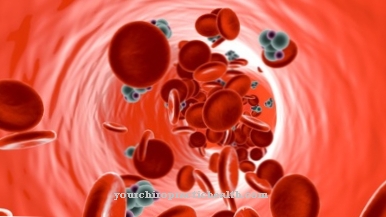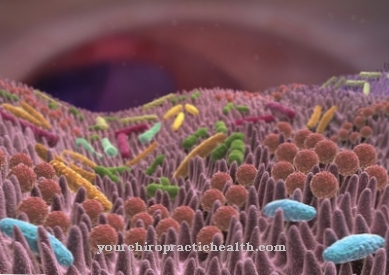The excitatory postsynaptic potential is an exciting potential in the postsynaptic membrane of neurons. The individual potentials are summed up spatially and temporally and can thus create an action potential. Transmission disorders such as myasthenia gravis or other myasthenias disrupt these processes.
What is the excitatory postsynaptic potential?

Neurons are separated from one another by a 20 to 30 nm gap, also known as a synaptic gap. It is the minimal gap between the presynaptic membrane region of a neuron and the postsynaptic membrane region of the downstream nerve cell.
Neurons transmit excitation. Therefore, their synaptic gap is bridged by the release of biochemical messenger substances, which are also known as neurotransmitters. This creates an excitatory postsynaptic potential on the membrane region of the downstream cell. It is a locally limited change in the postsynaptic membrane potential. This gradual change in potential triggers an action potential in the postsynaptic element. The excitatory postsynaptic potential is part of the neuronal excitation conduction and arises when the downstream cell membrane is depolarized.
The exciting postsynaptic potentials are received and processed by the following neuron by adding up both spatially and temporally. When the cell's threshold potential is exceeded, a newly formed action potential is carried away by the axon.
The opposite of the excitatory postsynaptic potential is the inhibitory postsynaptic potential. This leads to hyperpolarization on the postsynaptic membrane, which prevents the triggering of an action potential.
Function & task
The exciting postsynaptic potential and the inhibiting postsynaptic potential affect all nerve cells. When their threshold potential is exceeded, nerve cells depolarize. They respond to this depolarization by releasing excitatory neurotransmitters. A certain amount of these substances activates the transmitter-sensitive ion channels in the neuron. These channels are permeable to potassium and sodium ions. Local and graduated potentials in the sense of an excitatory potential thus depolarize the postsynaptic membrane of the neuron.
When the membrane potential is derived intracellularly, the excitatory postsynaptic potential is the depolarization of the soma membrane. This depolarization takes place as a result of passive propagation. There is a summation of individual potentials. The amount of neurotransmitter released and the size of the prevailing membrane potential determine the extent of the excitatory postsynaptic potential. The higher the pre-depolarization of the membrane, the lower the excitatory postsynaptic potential.
If the membrane is already depolarized above its resting potential, then the postsynaptic excitatory potential drops and under certain circumstances reaches zero. In this case the reversal potential of the excitatory potential is reached. If the pre-depolarization turns out to be even higher, a potential with an opposite sign arises. Thus, the excitatory postsynaptic potential is not always to be equated with a depolarization. It moves the membrane rather towards a certain equilibrium potential, which often remains below the respective resting membrane potential.
The work of a complex ion mechanism plays a role in this. With the excitatory postsynaptic potential, an increased membrane permeability for potassium and sodium ions can be observed. On the other hand, potentials with reduced conductivity for sodium and potassium ions can also occur. In this context, the ion channel mechanism is believed to be the trigger for the closure of all leaky potassium ion channels.
The inhibitory postsynaptic potential is the opposite of the excitatory postsynaptic potential. Here, too, the membrane potential changes locally on the postsynaptic membrane of nerve cells. Hyperpolarization of the cell membrane occurs at the synapse, which inhibits the triggering of action potentials within the framework of the excitatory postsynaptic potential. The neurotransmitters at the inhibitory synapses trigger a cell response. The channels of the postsynaptic membrane open and allow potassium or chloride ions to pass through. The resulting potassium ion outflow and chloride ion influx causes the local hyperpolarization in the postsynaptic membrane.
You can find your medication here
➔ Medicines for muscle weaknessIllnesses & ailments
Various diseases disrupt the communication between individual synapses and thus also the signal transduction at the chemical synapse. One example is the neuromuscular disease myasthenia gravis, which affects the muscle endplate. It is an autoimmune disease of previously unknown cause. In the case of the disease, the body forms autoantibodies against the body's own tissue. In muscle disease, these antibodies are directed against the postsynaptic membrane on neuromuscular endplates. Most often the autoantibodies in this disease are acetylcholine receptor antibodies. They attack the nicotinic acetylcholine receptors at the connection points between nerves and muscles. The resulting immunological inflammation destroys the local tissue.
As a result, the communication between nerve and muscle is disturbed, since the interaction between acetylcholine and its receptor is made difficult or even prevented by the acetylcholine receptor antibodies. The action potential can therefore no longer pass from the nerve to the muscle. The muscle is therefore no longer excitable.
The sum of all acetylcholine receptors is reduced at the same time as the receptors are destroyed by the immune activity. The subsynaptic membranes disintegrate and endocytosis creates an autophagosome. Transport vesicles fuse with the autophagsomes and the acetylcholine receptors change as a result of this immune reaction. With these changes, the entire motor end plate changes. The synaptic gap widens. For this reason, acetylcholine diffuses out of the synaptic cleft or is hydrolyzed without binding to the receptor.
Other myasthenias show similar effects on the synaptic cleft and the excitatory postsynaptic potential.

























.jpg)


